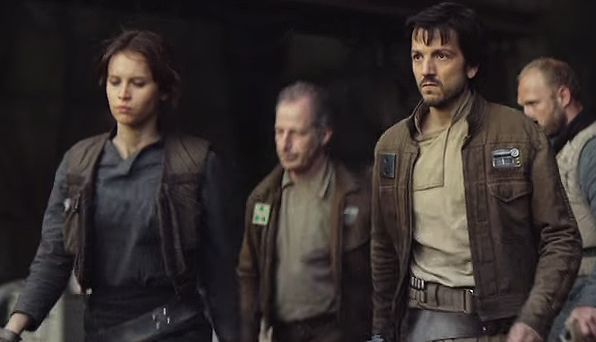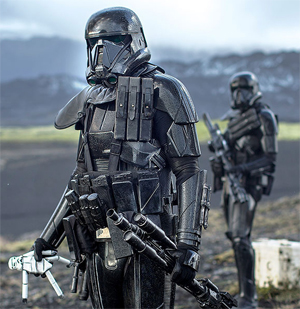HEAVY SPOILERS: ABANDON ALL HOPE YE WHO ENTER HERE

When Disney bought Lucasfilm and brought Star Wars back from the obscurity of tie-in media and into the 21st century of cinema through The Force Awakens, one of the most commonly heard complaints was that the movie was too safe. Unlike the prequels, that for all their failings had tried to explore new narrative territory, the first movie in the sequel trilogy seemed happy to give us three fantastic new characters and then drop them in the middle of common places, well-worn storylines, and a neverending series of cameos and winks to the past.
While it can certainly be argued that this nostalgic exercise was exactly what Star Wars needed to be a commercial powerhouse once again, Rogue One takes the opposite approach: it takes place in a very safe point in the timeline, one where X-Wings and stormtroopers and even Darth Vader are common place; it takes one of the most often told stories in Star Wars lore, that of the damned theft of the damned Death Star plans; and what it gives us is the most audacious Star Wars movie so far, one more than willing to alienate its typical family-friendly audience for the sake of telling the story it wants to tell.
One of the comments I heard when I left the theater, just one hour ago, was “man, the Alliance are assholes.” Gareth Edwards has been very open about this movie exploring the least clearly defined areas of the moral specter, but most of us expected this grayness to be epitomized by Saw Gerrera’s extremist faction. That’s not what we get. At all. To our surprise, Saw Gerrera ends up being the Obi-Wan Kenobi figure of this movie (if a particularly cruel Obi-Wan), giving his life to make our heroine finally decide to join the conflict between Rebellion and Empire, and Cassian Andor, who was depicted in the trailers as a more or less clear-cut hero, turns out to be a shady character with a very checkered past: the movie opens with Cassian killing a panicked informant to stop him from talking to the Empire, continues with his killing of one of Gerrera’s men without a second thought, and eventually sends him in an assassination mission. Even the strike team that eventually gets the plans, the “Rebel spies” mentioned in the crawl of A New Hope, turn out to be a group of saboteurs and assassins whose main reason to join the attack is to give some sense to all of the blood they’ve spilled in the name of the Alliance.
The leaders of the Alliance are not painted in a particularly heroic way, either. We see them split into factions. Mon Mothma and Bail Organa are indeed the heroic figures we’ve been led to expect, but the rest of members of the Council seem more than happy to sue for peace as soon as news of the destruction of Jedha City get to Yavin 4. This is not the heroic force fighting against evil just because it’s the right thing to do. If there’s an emotion that Gareth Edwards has always been able to depict with extreme efficiency that’s dread, and that’s what we see in every single character. We see the desperation in our heroes, in their leaders and even in the ambitious villain, Orson Krennic, that sees how the aspirations of a whole life can turn to nothing with surprising ease.

Opposing the Alliance, the Empire is depicted as a dark, all-powerful monster. Darth Vader, our dark knight, finally gets his dark castle and his creepy majordomo, with a lava moat thrown in for good measure. We see labor camps, cities under martial law, summary executions, and several other traits of authoritarian regimes that Star Wars had, until now, been more than happy to ignore or to show as silhouettes behind a curtain. There’s nothing sanitized about the way the Death Star works in this movie: we see the destruction and the horror in the faces of the people that see the inevitable death roll towards them.
Jyn Erso turns out to be the surprising moral center of the movie. At the same time that Cassian is shooting and murdering a member of a splinter Rebel group, Jyn is risking her life to rescue a little girl from incoming fire. When the leaders of the Alliance, the ones that are supposed to be the heart of the revolution, lose all convictions in the face of inimaginable destruction, it’s Jyn who reignites this fire in the hearts of a few, and eventually the whole Rebel Alliance, by using Cassian’s words and reminding him of what he fights for. Even Saw Gerrera, who’s supposed to represent the darkest side of armed revolt, sees in Jyn the humanity he’s lost after decades of war. Even though she’s no Luke, she still manages to be the light source of the story, but she does it without filling the Skywalker mold.

Rogue One could have played a familiar formula, but it refuses to do so. This is a fatalistic movie: it ends with death of every single of our main characters. And it’s something that we knew was going to happen, that is hanging on their heads through the length of the film. Rogue One is not a happy-go-lucky movie: it’s a heroic sacrifice stretched through two hours and fifteen minutes. And still, Rogue One is a Star Wars story: the main characters are thrown inside the crucible, faced with the unthinkable reality of a weapon capable of obliterating civilizations in a matter of seconds, and they find their morality put to the test. Chirrut and Baze are templars that learn to live–and die–without a temple, Cassian is an assassin that for the first time doesn’t kill his target, Jyn is a drifter that finally decides to join a cause: all of the characters are thrown into hell, and all of them end up choosing to do what’s right. Even though they lose their lives, they managed to achieve victory and to start the process that will end up with the defeat of the Galactic Empire.
Rogue One manages to portray a harsher reality that other saga entries have done before, but at the same time respects the theme that make Star Wars what it is: hope in the face of darkness. It goes one step ahead of what most summer blockbusters do, and shows us that the fight between the light and the dark is also inside of us. Inside the Rebel commando that kills innocents for the greater good and inside the Imperial scientist that helps build a superweapon just because he knows that he can make it vulnerable. Rebellions are built on hope, but they are also built on darkness.
Special thanks to Rachel and Cathy

Great review, Dave.
Overall the Darker Scope did stand out — it’s not a simple good vs. evil story. In fact, especially if you play out with the Catalyst info, both Ersos are used in order to be weaponize – Galen to weaponize the Death Star, Jyn to be the avenue to kill Galen.
It’s only when they end up resisting, stepping outside of the roles the Empire/Rebel Intelligence have for them, that good happens. They both go Rogue – and suffer for it – yet because of that, the Death Star plans get delivered and the Rebellion finally has a shot at victory.
I did like that it introduces a dirtier, darker Rebellion without equivocating or absolving. Cassian is not necessarily justified in his actions, nor is Saw — but even their dubious actions pale to the utter callousness of the Empire — perhaps a touch of warning about becoming what you fight (a la Luke looking at his own hand after cutting off his father’s).
+ + + + + + + + +
The second thing I keyed in on was how external hope was here. It was not a faith or belief in yourself – it was hope in others. There was a reliance upon others to help you, to do what is needed. I don’t think it was just a throw back to early screen plays that Chirrut says, “the force of others be with you”. This was not a “believe in yourself” movie – it was a believe in others. And that’s a powerful thing — especially as the reliance upon others saves the day – the personal power and in-fighting in both the Empire and the Rebellion is catastrophic.
This is an excellent review, and frankly shows that the Star Wars universe is just like ours – shades of gray instead of black and white.
Rebellions, whether legitimate or not, are rarely ever easy and without a little blood on their hands.
And while most of us are able to derive that by reading between the lines, it has been brought front and center with Rogue One. Sometimes the “good guys” do questionable things for the movement. But like the above comment mention, you have to tread a very thin line between fighting for what you believe in and becoming what you fight, which I also think was done exceptionally well by the movie.
This entry into the Star Wars universe was thought-provoking and brought on an emotional response in the theater for me that the other seven movies did not.